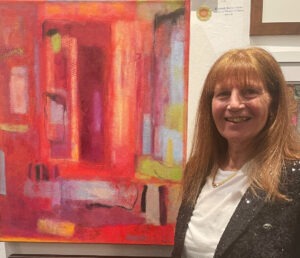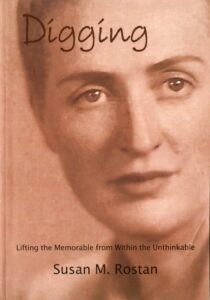
Meet The NAWA Artist/Author Susan
Rostan
Meet Susan Rostan a Signature NAWA Artist/Author
Some of our NAWA Signature Artists are
also recognized authors who have published their work in books, articles, and
papers both online, and offline. Their writing is as diverse as their artwork,
covering fiction, non-fiction, academic research, poetry, children’s books and
more.
A standard set of questions has been
proposed to each of our Artist/Authors. These are Susan’s replies.
NAWA IS PLEASED TO INTRODUCE SUSAN ROSTAN.

Susan Rostan
1. What are you focused on in your
writing?
Much of my academic research and
writing focused on developing children’s artistic talent and creativity. This
interest evolved into case studies of individual artists, and currently, a full
biography of renowned Long Island artist Stan Brodsky’s artistic development.
2. What drew you to the subject matter
of your work?
I have been an artist most of my life,
tutored by my grandmother who had her own atelier. My interest in artistic
development was instinctive, and an undergraduate degree in psychology gave me
a greater understanding of thinking and problem solving, After earning an MFA
in painting, I continued my studies in a doctoral program, focusing on
creativity in artists and scientists.
3. What type of writing do you do?
My non-academic writing has been in
the realm of narrative nonfiction. Digging: Lifting the Memorable from Within
the Unthinkable, published in 2013, was the story of how a few members of my
husband’s family survived World War II in Warsaw, Poland. My current manuscript
is historical nonfiction, tracing the life and art of Stan Brodsky. In this
endeavor, I am exploring the emergence and evolution of artistic and creative
thinking. To this end, I am writing for NAWA NOW, interviewing members for
special consideration, and co-leading NAWA’s Historical Research team,
developing biographies of NAWA Presidents, past and present.
4. Who are you writing for?
Who is your target audience? My
targeted audience is adult artists and non-artists interested in how artists
think, do what they do, and get to where they have arrived.
5. Is your written work related to
your artwork?
My writing isn’t specifically related
to my artwork but it is related to my thinking as an artist. To write about
another artist, or elicit meaningful discussions from another artist, I need to
empathize with their work and artistic development. This kind of empathy
emerges from my own practice. For example, my interest in color relationships,
composition, and movement sensitizes me to these qualities in the work of other
artists. This sensitivity also plays a part in my choice of words to use to
describe a scene and my awareness of the visual quality of my writing.
6. How often do you write?
I endeavor to write every day,
splitting my creative enterprise between writing and painting.
7. How do you balance your writing
with your studio practice?
In 2016, my studio practice became a
necessary part of my daily engagements with my creative impulses. After decades
of research and then a significant investment in writing narrative nonfiction,
I needed the hands-on manipulation of color and medium to satisfy my need to
generate new ideas and visual experiences. Stan Brodsky, who I had known since
his mentorship through my MFA encouraged me to return to concentrated studio
work. With his encouragement and the community of artists he had created at the
Art League of Long Island, I began to explore new options in my work. I had no
idea that he would subsequently ask me to do a favor and write his biography,
even as he pushed me to invest myself more fully in my artistic practice. The
consequences of my immersion in his life and artistic development have included
a deeper understanding of my work and the evolving flexibility in choosing
which enterprise I need to focus on. It has become a more graceful flow between
painting and writing.
8. When did you write your works?
My published scholarly writing began
in 1992, after completing my doctorate. I continued publishing my research
through 2008. In 2013, I published my first work of nonfiction, Digging:
Lifting the Memorable from Within the Unthinkable, and began writing
Brodsky’s biography in 2017.
9. Are you currently writing articles
or books for publication?
Since joining NAWA in 2022, I have
been a contributing writer for NAWA NOW, focusing on the artistic development
of celebrated NAWA members.
Digging by Susan Rostan an
Artist/Author Signature Member of NAWA
10. How and where have your works been
published? Online? Print?
My scholarly work is in peer-reviewed
print journals. My book was self-published in print and digital formats.
11. Do you self-publish your writing?
My first book was published by an
independent publisher, giving me ample opportunity to participate in most
aspects of the process.

Digging by Susan Rostan an Artist/Author Signature Member of NAWA
12. How do you market your written
work?
Much as most contemporary publishing
endeavors, a great deal rests on the author. I learned how to participate in
workshops and community reviewing to elicit reviews of my work and
opportunities for blogged interviews. Through Independent publishing services,
I was also able to enter my work in competition and reaped the rewards of a
beautifully executed book.
13. Do you do book readings? Promo
tours? Library lectures?
My marketing endeavors have included
book readings discussions, and library lectures, all building on the skill set
developed from presenting my academic research at national and international
conferences.
14. Where can people access your
publications? Links? Libraries?
My academic research is cited on my
website: SusanMRostan.com. Digging is
available on Amazon.com. My artist
interviews are available in NAWA NOW.
15. In a few sentences tell us who and
why people might feel compelled to read your publications.
As an artist trained in close and
intensive observation of the world around me, I have brought this proclivity
and skill set to my explorations of artistic and creative development in its
varied manifestations.
___________________________________________________________
Congratulations and Thank you for
sharing!
Mary Ahern – Chair: NAWA Public
Relations Committee
National Association of Women Artists
NAWA. Empowering Women Artists
Since 1889
https://thenawa.org/meet-the-nawa-artist-author-susan-rostan/